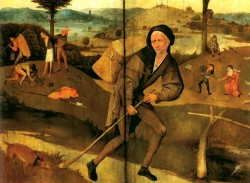
Graziani 1982
“Bosch’s Wanderer and a poverty commonplace from Juvenal” (René Graziani) 1982
[in: Journal of the Warburg and Courtauld Institutes, XLV (1982), pp. 211-216]
[Not mentioned in Gibson 1983]
The Canadian author Graziani, who points out that Tuttle’s article (see Tuttle 1981) came to his notice when his own article had already been written, believes that the ‘dog attacks poor vagrant’ motif should not exclusively be related to the Franciscan idea of ‘voluntary poverty’. According to him Tuttle has correctly pointed out that, because of the detail with the growling dog, the subject of the exterior panels of the Haywain triptych focuses on poverty, but she has analyzed the iconography of the exterior panels in an unsatisfactory way. Graziani himself uses the title The Wanderer for these exterior panels and interprets the protagonist as an image of ‘cheerful, patient poverty’, a medieval topos that warned of the disadvantages of material possessions and can be traced back to a verse by Juvenal: ‘Cantabit vacuus coram latrone viator’ (the poor traveller will sing a song when he meets a robber). The figure in the exterior panels is a moralizing opposite of the people in the central panel who are deceived by the temptation of worldly wealth. It is true that Bosch’s wanderer is not singing but this aspect is represented by the shepherd playing the bagpipes and the dancing farmers in the background. Graziani points out that Juvenal’s verse was widespread in the Middle Ages and that it was a major theme of the discussion about riches and poverty. Bosch probably knew the topos from sermons. In a sermon of Geert Grote (founder of the Modern Devotion) Juvenal’s verse is being paraphrased.
Basically Graziani’s method (to interpret Bosch’s images with the help of medieval topoi) seems okay. It stands to reason, though, that not every topos can be related to Bosch in an arbitrary way: only those topoi that fit in with the context of Bosch’s art qualify. It should be pointed out then that Graziani’s Juvenal topos does not fit in with the context of the Haywain’s exterior panels. The protagonist is obviously not singing a song and moreover, his expression looks rather wary instead of cheerful, as is signalled by Graziani himself. That the ‘cheerful’ aspect is represented by Bosch through the shepherd playing the bagpipes and the unworried dancers is a very weak argument, particularly if one is aware of the negative connotations of the topoi ‘playing the bagpipes’ and ‘dancing’ in the Late Middle Ages. A weak element is also Graziani’s suggestion that Bosch’s exterior panels agree with the traditional medieval view on poverty as a situation that can easily lead to bliss (compare Luke 6: 20), whereas circa 1500 middle-class moralists increasingly began to rebuke poverty as a result of voluntary self-neglect. In other Bosch paintings (such as the right interior panel of the Garden of Earthly Delights triptych and the exterior panels of the Vienna Last Judgment triptych) Bosch treats beggars in the same negative way as is the case in the contemporary texts and visual sources signalled by Graziani.
But the major objection against Graziani’s argument concerns his interpretation of the Rotterdam tondo. Suddenly this panel is not called The Wanderer, but The Pedlar: one wonders for which reason. Graziani supposes that this pedlar is a representation of ‘voluntary poverty’ because the ox behind the gate is a traditional symbol of Patientia (Patience). Moreover, just like the wanderer in the Haywain, the tondo’s protagonist does not have to fear robbers: the man who is flirting with a woman in the brothel’s doorway is a landsknecht and the robbers in the Haywain are also soldiers. Actually, in the tondo there is not even a hint of a robbery and so once again the Juvenal topos is not relevant here. The link that Graziani observes between the soldiers in the tondo and in the exterior panels is based on sheer Hineininterpretierung.
[explicit 2000]